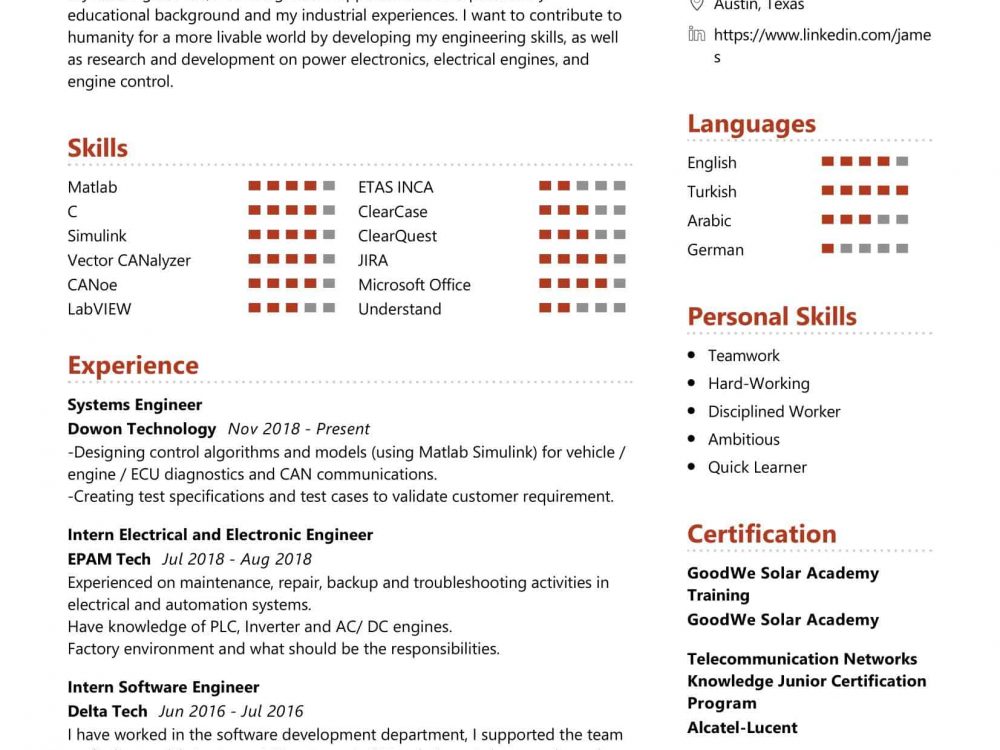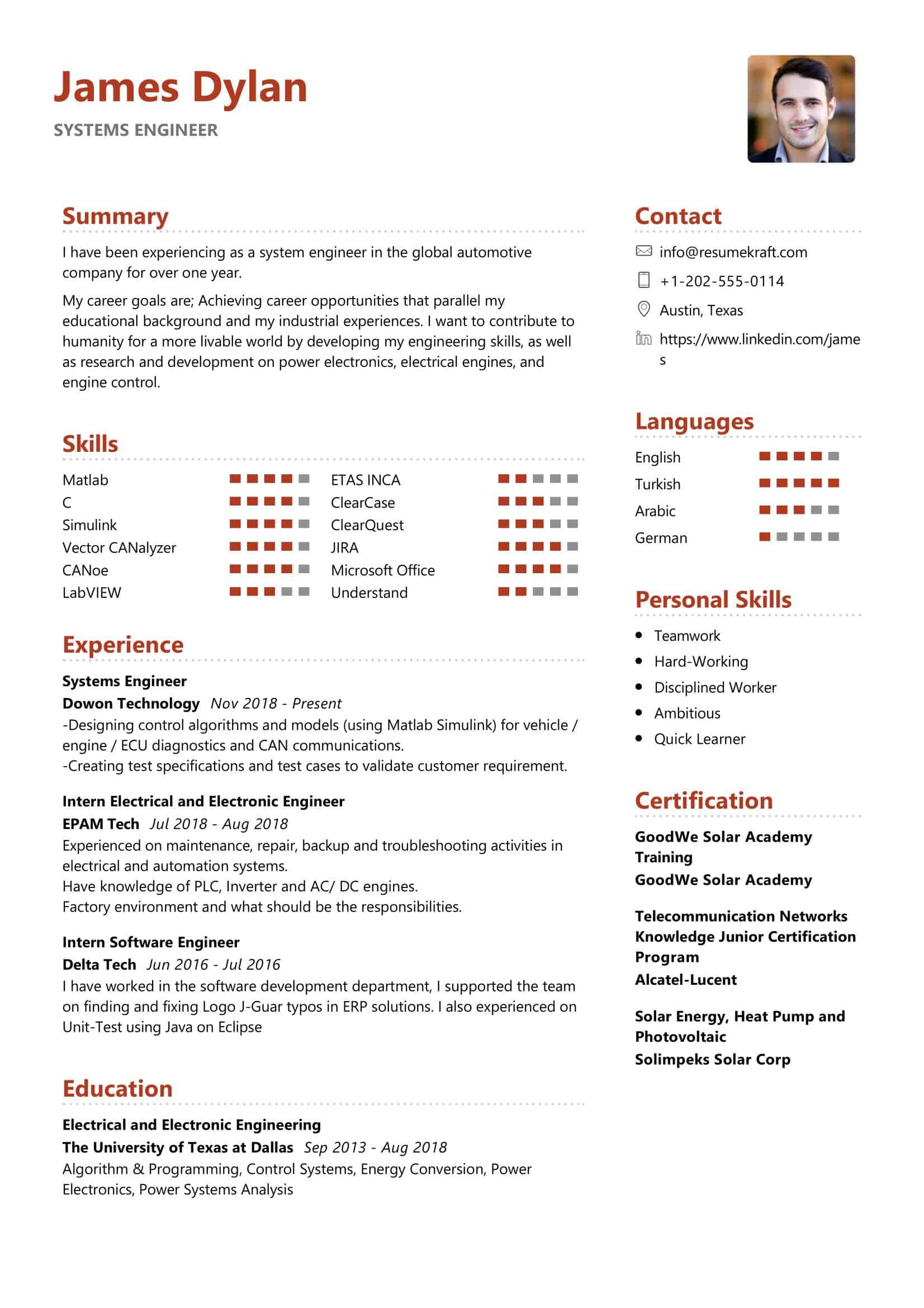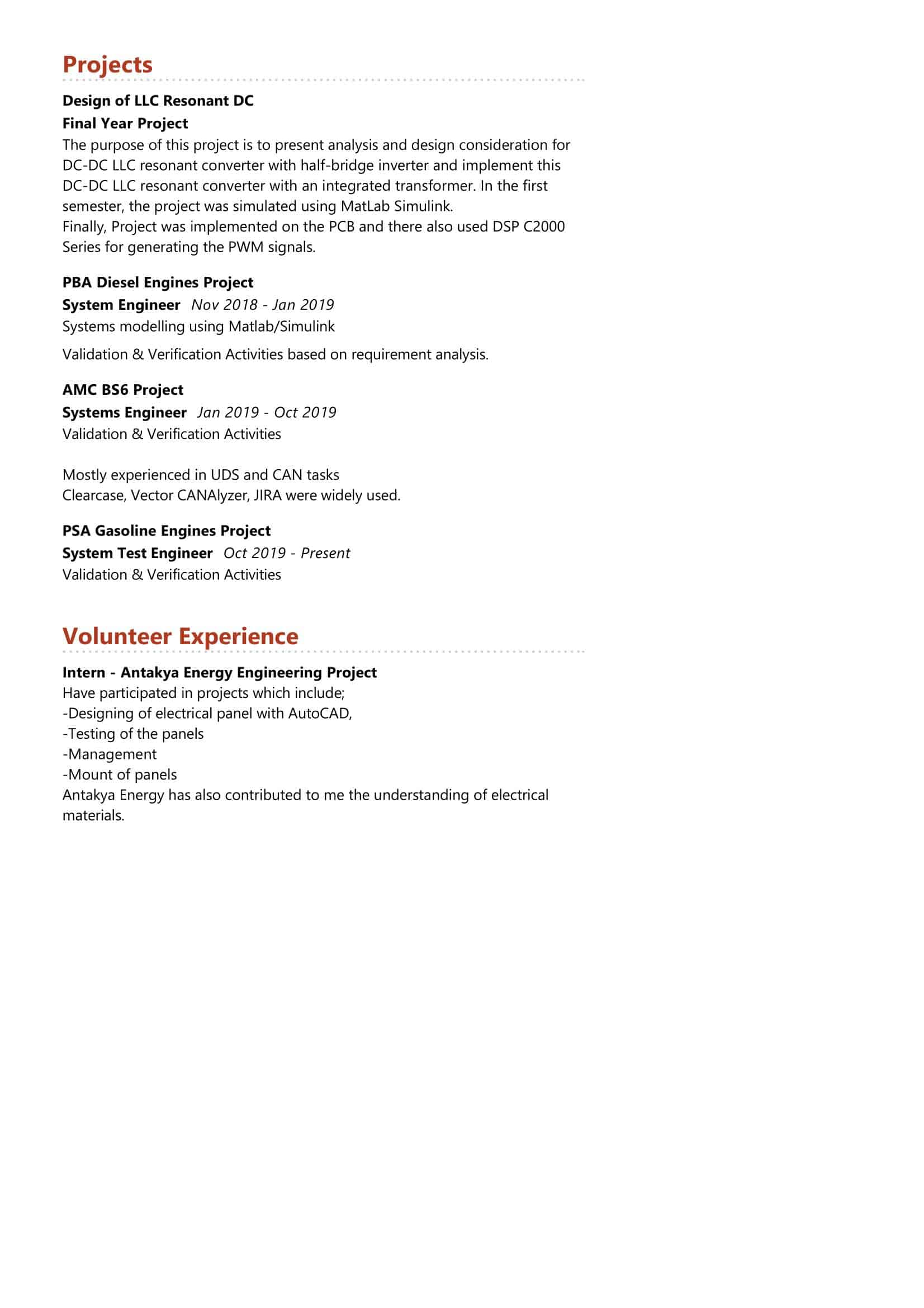Systems Engineer Resume with Writing Guide
A System Engineer Resume is the most important document employers will see when they are considering someone for a position in the field. Whether you are applying to be a Systems Engineer or you have already been employed, this guide has everything you need to know about writing one. When it comes to resumes, it’s important to choose the right format and tailor your resume for individual job opportunities. What an engineer writes on their resume and how they present it is likely the most important factor in getting a job. Check out this guide for help with resumes and cover letters tailored just for you!
Step 1: Customizing your resume
With some knowledge of what to say on your resume, where to place it, and which company you want to work for, start creating your professional Systems Engineer Resume. Your resume should not be longer than two pages. In the first paragraph, briefly introduce yourself. Include your general employment objective and what you are looking for in the position. In the second paragraph of your Systems Engineer Resume, talk about your educational background, give any relevant course work, and say what degree you received. If you have special certifications or licenses that are pertinent to the job description then list those next. If not, then proceed to listing your work experience starting with your most recent position in reverse chronological order. Additional information you might want to include is your relevant professional certifications.
Step 2: Putting it all together
Create a nice layout for your Systems Engineer Resume. After you have all of the pertinent information in the right order and on the right pages, take a look at how it looks and make sure that everything is connected correctly and that your formatting (font, margins, paper size) is correct. You can get Professional Resume Templates Online at this link to help you with formatting.
Step 3: Sending it out
Once you have completed your Systems Engineer Resume, create a PDF and send it to all of the companies you are interested in. In your email you should include the title of your resume, a resume cover letter (short describing why you are a good candidate) and any necessary attachments.
Systems Engineer Resume Writing Guide:
This guide has been written and designed for entry-level Systems Engineers, however, it is applicable to everyone. It is important to note that the hiring manager sees hundreds of resumes a day so it is essential that resumes are tailored to each job posting. The systems engineer resume writing guide below contains expert tips that will help you make your resume stand out from the competition.
A great resume is one that highlights your experience, skills, education, and accomplishments. If you want to see your resume stand out amongst the competition then it is absolutely essential that you customize your resume to each job posting that you apply for. Below, we will teach you how to write a professional systems engineer’s resume.
Wondering what goes on inside the mind of a hiring manager when he or she looks at a resume? In our experience, a hiring manager looks at dozens of resumes every day and they do not have time to go back and forth between multiple pages when looking for specific information. The hiring manager’s priority is to quickly scan and find the specific information they are looking for. You can make your resume stand out from the competition by customizing it to the specific job posting that you are applying for. Below, we will teach you how to write a professional systems engineer’s resume.
Our goal with this guide is not to teach you how to build a system engineer resume, however, but rather how you can customize and tailor your resume to the specific requirements of each job posting that you apply for. We here at ResumeKraft believe that your resume is an important document that can help keep you from being overlooked by a hiring manager. Make it easy for the hiring manager to see your skills and experience by following our guide below!
This guide has been written and designed for entry-level Systems Engineers, however, it is applicable to everyone. It is important to note that the hiring manager sees hundreds of resumes a day so it is essential that resumes are tailored to each job posting.
List of Typical Responsibilities For a Systems Engineer Resume:
- Design and implement solutions for enterprise infrastructure.
- Plan solutions that are reliable, accessible, and secure.
- Create architecture diagrams that convey ideas in an understandable format.
- Select software products to configure and maintain company information systems.
- Develop computer programs to monitor the status of company networks and hardware components.
- Create procedures and best practices for computer networks and hardware.
- Develop user training materials for the company’s systems.
- Work with small-business system vendors to ensure accurate documentation of customer systems specifications, including system performance measures and product integration methods for application software.
- Communicate with and train the end users on the use of a new system being implemented at the client’s organization.
Top 10 Must-have Systems Engineer Skills:
- Experience as a Systems Engineer.
- Software Engineering skills.
- Strong fundamentals in any programming language(s) that are relevant in the job role.
- An understanding of IT Systems, System administration and IT Infrastructure (TCO) management.
- Ability to work effectively with Engineering resources and support teams, such as the IT Operations, Networking and Security teams within the organization..
- Understanding of technologies used by Systems Engineers including forums for code sharing, development tools & platforms, automation tools (e.g. Jenkins, Build & Release).
- Understanding of the industry needs and trends (notably relevant to Systems Engineers), such as Cloud, Virtualization, DevOps and Development.
- An understanding of the Systems Engineering Process and how they work with business needs..
- An understanding of the organizational structure of a systems engineering organization..
- An understanding of the requirements placed on engineering resources by Systems Engineers and on the systems they manage, including understanding their impact on performance metrics used to measure what is delivered to end-users.
Tips to write a Systems Engineer Resume Summary:
- List your skills and tools in a bulleted list.
- State the summary of your military experience, such as “Systems Engineer with experience in…”
- Highlight your achievements with bullet points of attributes that you have.
- Make an impressive executive summary of yourself as a Systems Engineer professional.
- Avoid using acronyms or explaining terms, unless essential for understanding how systems engineering contributes to the goals of the company.
- Use your Systems Engineer resume bullet points to create a Systems Engineer cover letter that will emphasize why you are the right candidate.
- Keep the Systems Engineer Resume objective clear and concise and avoid any cliche sentences.
- Tailor your resume to each job that you apply for, taking into account any attachments they specify on their “To whom it may concern” message.
How to write a Systems Engineer Resume with No experience:
Use a professional resume template:
If you do not have any prior job experience as a Systems Engineer you will need to use a professional resume template. This will allow you to include the most important elements of resume writing and show off your talents. You can customize this to fit your needs and add extra information as needed. Be sure to include keywords specific to the job description. It is also recommended that you have one professionally written for you to make sure it is done correctly from start to finish.
Choose the right format:
Make sure to choose the right format for your resume. The two most common formats are chronological and functional. A chronological resume lists your previous experience by date, starting with the most recent. A functional resume focuses more on what you have accomplished instead of where you worked or what tasks you completed at each job.
How to write a Systems Engineer Cover Letter:
- Include an eye-catching cover letter
Systems engineer cover letters should be professional, yet bold. Cover letters are often a make-or-break opportunity to instantly grab an employer’s attention and get noticed. You will want your cover letter to convey your ability to be a leader in the field, but also prove that you are not only a hard worker but can also think on your feet, figuratively speaking. Your cover letter should include one or two things unique about you, something that sets you apart from other applicants. - Put your experience on paper
You will need to have a great deal of experience to be considered for the position you are applying for. It is a good idea to use bullet points in listing your experience, but make sure that the information is relevant and to the point. It is not necessary to include every single project you have worked on; it is better to include just the most outstanding or relevant projects. You want employers to be able to skim through and get a feel for your work history quickly and easily, so make sure that all of your information is easily readable by doing this. - Use a professional format
While it may not be common, you should use the more formal “Dear Sir/Madam” title when writing your cover letter to an employer. In order to make sure that you are addressing the company correctly, the Information on this website has a guide on how to address companies and individuals. The format of your cover letter will be fairly simple; it should consist of information about yourself, your experience, and a little bit of writing introducing your work history. - Include personal information
You should include anything personal about yourself in your cover letter. This may include information about you that is not normally public information, such as hobbies, why you chose the position you are applying for, or anything else that is relevant to the position you are seeking. Some people consider this to be a bad thing to do, but it can help make your cover letter more interesting for an employer and stand out from others. - Examples of a good resume
Try to keep your resume simple. It is a good idea to put one or two key projects that you are most proud of at the top, as it will attract your potential employer’s attention right away. You will then want to include your work history, making sure not to leave relevant information out or skip around too much. - Know the position for which you are applying
It is important to know everything you can about the position before embarking on your job search.
Key Takeaways:
- Always let your writing be the first impression for a potential employer. Your resume is the first thing that will get through to an employer’s eyes. Ensure you are presenting yourself in the best light.
- Balance what is most important with what is most relevant: If you have 10 years of experience in software development, but only 2 years of HDL experience, it would be more appropriate to include this experience than program test automation (which would become less important over time).
- Proofread your resume. Ensure that it is free of spelling and grammatical errors.
- Make use of keywords: Ensuring you have the right keywords will greatly increase your chances of getting through to the next round in a job application process.
- Keep it clean: Keep your resume to one page (2 pages at the most). Employers do not want to sift through pages and pages of irrelevant information.



